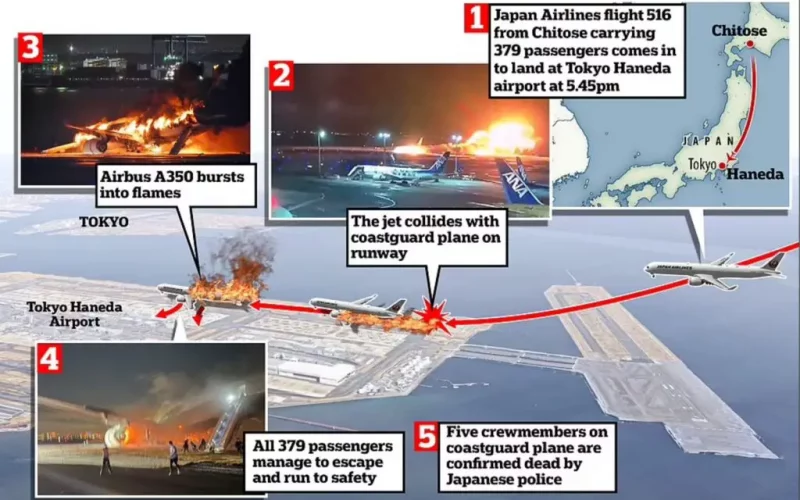Five people were killed when a coastguard plane crashed with a Japan Airlines passenger flight landing at Tokyo’s Haneda International Airport, with just one crewmember surviving with serious injuries.
Coastguard flight MA-722, a Bombardier Dash-8, collided with JAL flight 516, a considerably bigger Airbus A-350, on runway C at Haneda, with both planes exploding into flames.
Shocking video showed the Japan Airlines plane engulfed in flames as it sat on the tarmac, with flames spilling out of the passenger windows.
One horrifying video showed flames licking the main cabin door as twisted bits of metal fell from the fuselage onto the tarmac, while another showed passengers sprinting along the runway to escape the blaze, running away from the engines, which were spewing out chunks of flaming debris.
The passenger escape slide projecting from one of the airliner’s doors was set ablaze while further flames blazed inside the cabin, and the aircraft’s hull eventually broke in two as the fire melted through significant pieces of its bodywork, according to images from the incident.
All 379 passengers and crew on the Japan Airlines aircraft were miraculously removed from the crippled jet, according to a JAL spokeswoman, while the majority of the crew on the much smaller Bombardier did not survive the collision.
According to the Jiji news agency, the coastguard jet was scheduled to travel to assist with rescue operations after a huge earthquake in central Japan on New Year’s Day, with the five crewmembers’ deaths exacerbating the sorrow.
Tetsuo Saito, Japan’s transport minister, told reporters that the captain of the coastguard plane fled and lived but was hurt, but he cautioned that ‘we’re not at the stage to explain the reason of the disaster.
When the catastrophe happened, the Japan Airlines aircraft had taken off from Shin Chitose airport in Japan and was on its way to Haneda airport.
The evacuation of the passenger airliner was regarded as “phenomenal” and “miraculous” by many experts.
Professor Graham Braithwaite, director of transport systems at Cranfield University in the UK, told BBC: “The evacuation has been successful and it is a reminder how much has gone into training cabin crew.”
“Their focus is on safety,” he added. “They are the last people to evacuate the airplane and on face value, it looks like they have done an incredible job.”
A coast guard spokesman at Haneda Airport, one of the busiest in the world, said they were ‘examining information’ of the alleged incident and could not confirm what had occurred at first.
“It’s not clear if there was a collision. But it is certain that our plane is involved,” he told AFP.
However, spokeswoman Yoshinori Yanagishima subsequently confirmed to Japanese media that their jet collided with the JAL flight on the runway.
According to NHK, one member of the coastguard plane’s crew escaped.
The remaining five were missing, but authorities eventually determined they were dead.
Prime Minister Fumio Kishida hailed the killed crew members for their efforts to assist earthquake victims.
“These were employees who had a high sense of mission and responsibility for the affected areas. It’s very regrettable,” he told reporters.
“I express my respect and gratitude to their sense of mission,” Kishida said.
According to Japan Airlines, the passenger jet collided with the second aircraft after touching down on a runway or a taxiway, according to Kyodo.
Television footage showed flames shooting out of windows and the plane’s nose collapsing as rescuers blasted it with water hoses. On the runway, there was also flaming debris.
The Ministry of Land, Infrastructure, Transport and Tourism said it was probing the incident, Kyodo said.
According to NHK, more than 70 fire engines were sent to the location to put out the roaring blaze.
Wide angle photographs of the event revealed a major stretch of the runway completely engulfed in flames, with debris covering vast swaths of the tarmac.
Meanwhile, video from inside the plane showed the cabin filling with dense smoke.
Swedish passenger Anton Deibe, 17, told the Swedish daily Aftonbladet that “the entire cabin was filled with smoke within a few minutes. We threw ourselves down on the floor. Then the emergency doors were opened and we threw ourselves at them.”
“The smoke in the cabin stung like hell,” he added. “It was a hell. We have no idea where we are going so we just run out into the field. It was chaos.”
Japan hasn’t had a major commercial aircraft disaster in decades.
The deadliest incident occurred in 1985, when a JAL jumbo aircraft traveling from Tokyo to Osaka crashed in the central Gunma area, killing 520 passengers and crew.
That accident was one of the world’s worst single-flight jet disasters.
In the United States, there have been no domestic airline crashes since 2009, and no major U.S. airline has had a crash since 2001.
The horrifying episode at Haneda airport occurred only one day after a devastating 7.6 magnitude earthquake destroyed wide swaths of Japan’s west coast, killing hundreds of people and leveling tens of thousands of houses.

